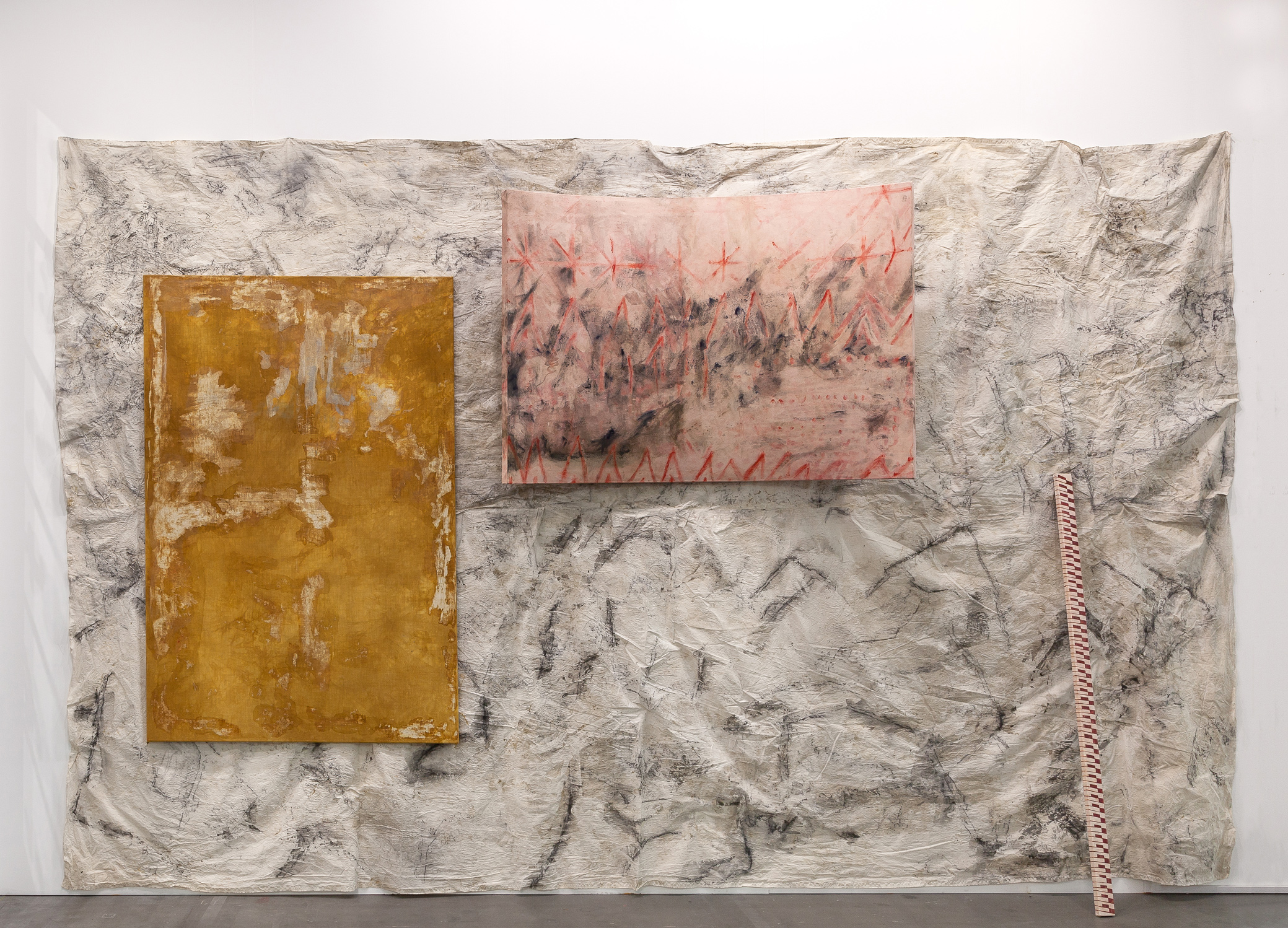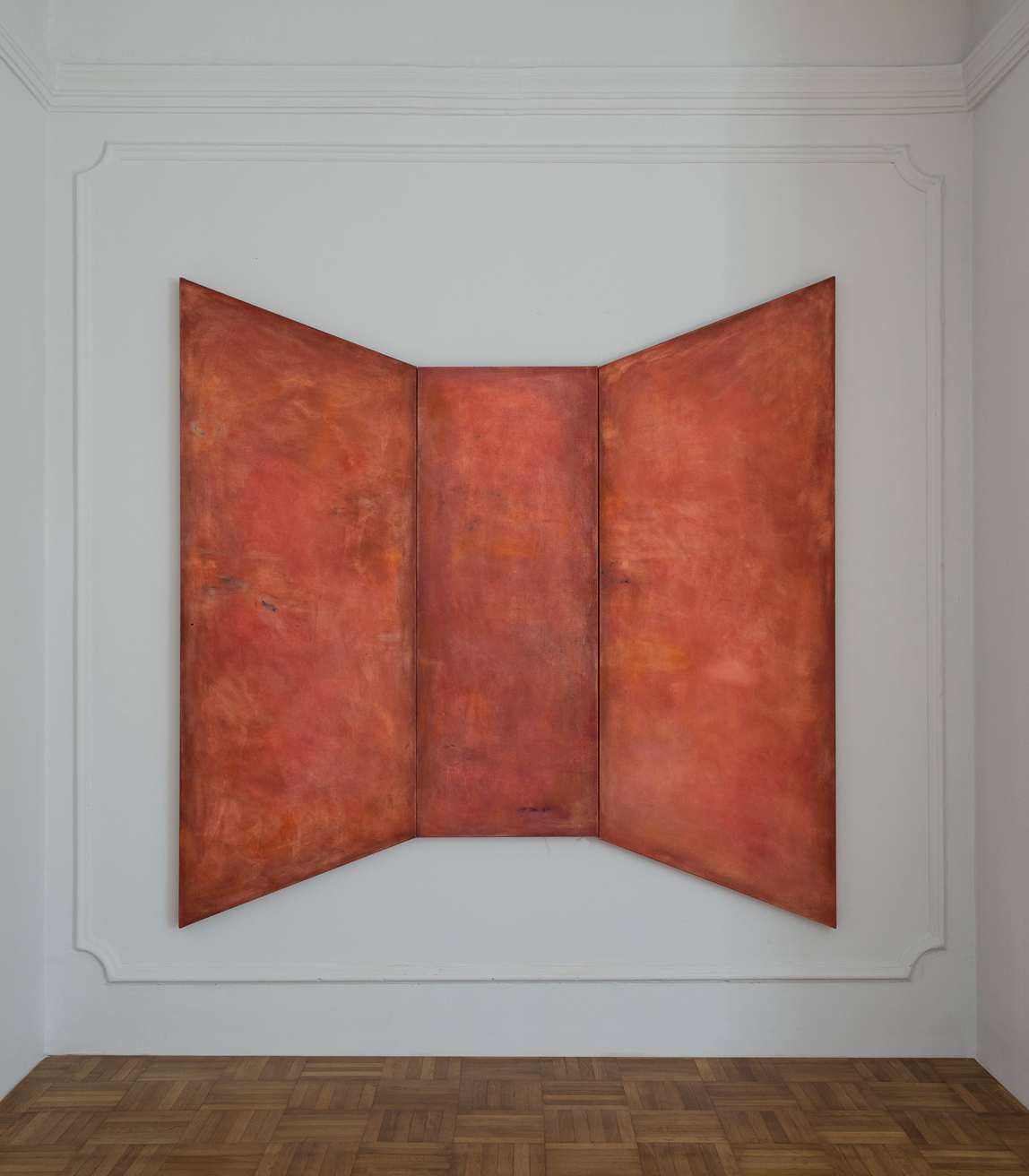Challenging the perspective: on the art of Nina Zeljković
Nina Zeljković in the Eugster || Belgrade booth at Artissima 2022 was a gem from the fair’s emerging sector. Here is a take on her art
I’ve been following the work of Serbian, Hamburg and Belgrade-based artist Nina Zeljković (b. 1985) for some time but finally saw it for the first time in real life at this year’s Artissima. Her paintings at the booth of Eugster || Belgrade (a duo with Saša Tkačenko) – some of which of large scale, shaped and framed canvases, all mixed media, all 2022 – tightly interrelated with the public. One had to wonder about the extensive research behind them, not limited to a pictorial quest. Speaking to the artist, [1] I learned about the different aspects that inform her practice. Perceiving a lack of discourse growing up in Belgrade in the 90s and 00s, she stresses the idea that painting needs an entry point, which for her became the 2015 class of Jutta Koether in Hamburg. Coming from philosophy, the artist considers her German experience an “eye-opener”, mentioning she still misses the way art was discussed in those days.

Zeljković’s art revolves around the body, although it is not depicted. Its potential, a physical agency, is what manifests instead, a shift that leaves me with the question of how the its manifestation relates to space and images in her art. She says: “It comes from my uneasiness with representation, which I identified already during my studies. I wanted to break with the endless stream of images and that’s how I found my way to the iconoclasts. The big motivation is to bring back the body into real space to experience the paintings’ fleshy presence.”

The mention of Byzantine art during our conversation was compelling and affinities with this historical period are easily found in Zeljković’s work. This reference from the past is vital, especially the idea of “reverse perspective”, a perspective model developed in the Eastern roman empire and a prominent tool of the Eastern Orthodox canon. In this paradigm, the projection lines that converge – as they do in linear perspective – are drawn as diverging against the horizon, depicting the space as it was opening up. The vanishing point doesn’t lie within the pictorial space but rather in the viewer’s place. “This is something usually explained trough a Western model, that’s why the name “reverse”, that is, in relation to the central point perspective; the idea is to instead offer another or more points of view. It is rather a synthetic view, aligning with the idea of Decentralization that matters to me; viewing the image from the bottom up, resisting representation as a way to break with the hegemony of the image and, most importantly, to bring the body back into the space through a moving, spatially situated viewpoint,” continues the artist.

Temporary spaces and underground territories such as early Christian catacombs are also important in Zeljković’s research, sometimes literally: In 2021, during the pandemic, the artist took a 10594 km long journey through Turkey, visiting Iconoclast churches, underground cities, and early Christian monk’s caves. The way people were living with and among paintings, adorning their abodes with symbols and ornaments, also using them as signals for pigeons with whom they were living symbiotically and in a sustainable way, spoke to her of recurring themes: the immediacy of painting; the presence of the painted body along with that of the painter in the way representation depended on the artist’s physical reach—the constrained space of a cave limited the extension of brushstrokes, the painter’s arms length even.

Here, Zeljković delves into communities on the fringe, people fleeing persecution because of their dissident ideas. She says: “The Underground was always the most fruitful place for radical ideas. I can’t say where this underground is today but I like the model that Peter Lamborn Willson proposes, having to do with temporary autonomous zones, a socio-political tactic of creating temporary spaces that avoid formal structures of control. For me, my studio space is a bunker, and a monk cave, a place of urgency and a refuge. I like to fantasize about iconoclast situations, putting an end to the stream of images and create something new from that point on. This is the situation I like to perform in my artworks, which could be autonomous zones where others can participate.“
It is no coincidence that, whether through Byzantine art or the descend into early Christian caves, the sacred asserts its heavy presence. “Sacral spaces are the prime examples of the Gesamtkunstwerk, a place where one can experience immersion. I want to be immersed; I no longer want to view artworks through phone screens. I work large scale with architectural elements, and I want them to be lightweight so they can affect and change the existing architecture in an easy and soft way. I also work with shaped canvases that are curved or bent: they can tower over you; you can enter them; they can hug you—the observer is in the work but can’t fully grasp it, like a site-specific, expanded painting,” says the artist.

Zeljković’s desire is to turn away from the polished image towards an artwork that is provisional. She adds: “Like the Byzantines, rendering doesn’t interest me much. I enjoy open works, those that expand beyond. I am also drawn to the non-productive attitude and negative work.” Artists such as Support/Surfaces, René Daniëls, Isabella Ducrot, Mario Merz, Josef Strau, Carla Accardi, Richard Tuttle, and Jean Fautrier get a mention.

What brings all these artists together, except Zeljković’s liking indeed, might be a sense in which an attitude reflects on one’s art. That is close to her going about studio practice: While her conceptual framework is as tight as it might seem, the work is very process-based and cannot be anticipated; it has to be experienced. She says: “I want to do everything myself from stretching and sizing; these are all important steps, because I also want to grasp the dimension and feeling of the canvas. I mix my own colors and mediums and I rely on old recipes and procedures, following the laws imposed by the material. I guess I can enact all my childhood ideas now and bring them to another level.”

I began this text with the relevance if Hamburg in Zeljković’s life, but will end it with Belgrade, her city, the one she had to leave but eventually found back. An important role in her move is the collaboration with gallerist Mirko Lubarda and his space Non Canonico, which presented her solo show “Ellipsis of Tunica Retina” in September 2022 just before the Eugster || Belgrade booth at Artissima. However, her biggest motivation for the return is her house/studio with garden by the Sava river on the outskirts of Belgrade, built by her grandparents in former vineyards, a place that comes with the size and history required by the artist in this precise moment of her career, nesting the production of her works in the two exhibitions. The property, which is partially being redesigned to include the studio space, is also becoming a residency for fellow artists from the rest of the world. It is about autonomy again, the need of creating one’s own platform. Zeljković continues: “In a wider sense the idea of decentralization in the arts is affecting living conditions. It is a proposal to reposition in relation to the scene or the “center” in order to find this center within: the principle of the satellite, as an attempt to establish a structure abandoned in the post-post times. It is in connection with my interest in the fringe communities and liminal spaces, the underground. Serbia is this in-between place, between east and west, and this is also how I feel myself.”
[1] All quotes are from a conversation that took place in November 2022.
December 13, 2022
